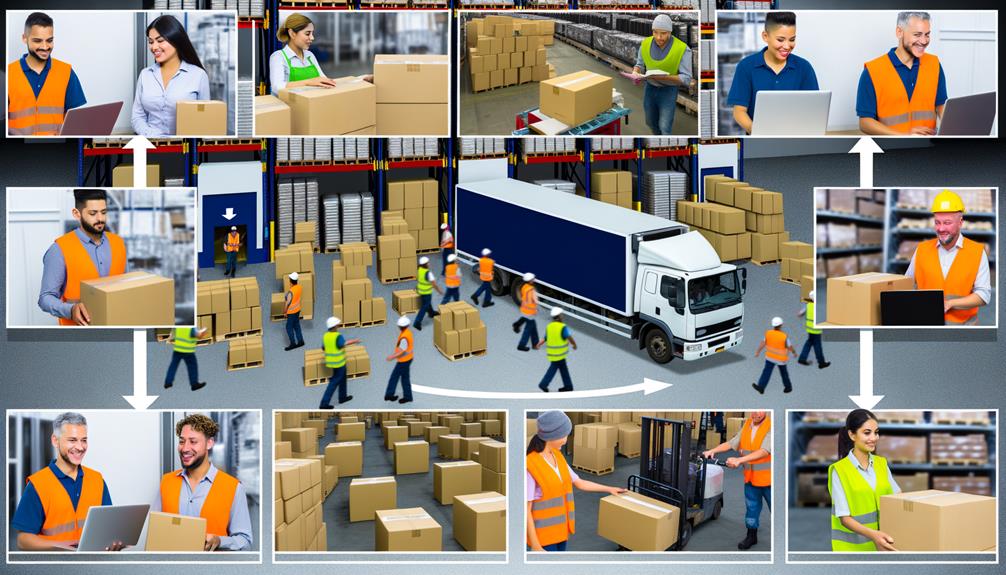As someone immersed in the world of logistics and supply chain management, I’ve learned just how vital efficient cold chain operations are.
It’s all about preserving the quality and safety of temperature-sensitive goods throughout the entire supply chain.
This requires a deep understanding of the complexities involved and innovative solutions to optimize efficiency.
In this article, we’ll explore the strategies and technologies revolutionizing cold chain operations, from temperature monitoring to network design.
Join me on this journey to master efficiency and transform the cold chain industry.
Temperature Monitoring and Compliance
I rely on temperature data loggers and IoT solutions to accurately monitor and comply with temperature requirements in the cold chain.
Using temperature data loggers for compliance is crucial in ensuring the integrity and safety of temperature-sensitive products during storage and transportation. These loggers provide real-time temperature monitoring, allowing me to track temperature variations and identify any deviations that may occur.
By tailoring monitoring systems to specific cold chain requirements, I can ensure that the temperature-sensitive products are kept within the required temperature range at all times. This level of precision is essential in meeting regulatory compliance and maintaining the quality of the products.
Cold Chain Network Design
To ensure efficient cold chain operations, it’s essential to carefully design the network in order to minimize vulnerabilities and optimize supply chain management. Cold Chain Network Redesign involves analyzing the current network structure and making strategic improvements to enhance resilience.
Key steps in Cold Chain Network Design include:
- Network Assessment:
- Evaluate existing infrastructure, including storage facilities, transportation routes, and distribution centers.
- Identify bottlenecks and areas of improvement.
- Risk Analysis and Mitigation:
- Identify potential disruptions, such as power outages or natural disasters.
- Implement contingency measures to minimize the impact of these disruptions.
Cold Chain Packaging
After carefully designing the cold chain network to enhance resilience and optimize supply chain management, it’s crucial to address the subtopic of cold chain packaging to ensure the safe transportation of temperature-sensitive goods.
Cold chain packaging plays a vital role in maintaining the integrity of perishable products throughout the entire supply chain. To meet sustainability initiatives, innovative packaging materials are being developed that not only provide excellent insulation but also minimize environmental impact. These materials include biodegradable and recyclable options that reduce waste and carbon footprint.
Additionally, advanced packaging technologies such as phase change materials and vacuum insulation panels help maintain the desired temperature range for an extended period.
Cold Chain Transportation Optimization
Cold chain transportation optimization focuses on maximizing efficiency and ensuring the safe transport of temperature-sensitive goods throughout the supply chain. To achieve this, there are key strategies that can be implemented:
- Real-time monitoring solutions: Utilizing temperature data loggers and IoT enabled transportation, we can have accurate and up-to-date information on the conditions of the goods during transit. This allows for immediate action in case of temperature deviations.
- IoT enabled transportation: By incorporating IoT technology into transportation processes, we can streamline operations and improve efficiency. This includes features such as real-time tracking, remote temperature monitoring, and predictive maintenance.
Compliance and Regulatory Considerations
By incorporating compliance and regulatory considerations into our cold chain transportation optimization strategies, we can ensure the safe and efficient transport of temperature-sensitive goods throughout the supply chain.
Compliance audits play a crucial role in verifying that our operations meet the necessary standards and requirements. These audits help identify any gaps in our processes and allow us to take corrective actions to ensure compliance.
Additionally, staying updated with regulatory updates is essential to avoid disruptions in our cold chain operations. Regulations and guidelines can change over time, and it’s crucial to stay informed and adapt our processes accordingly.
Read More:
Revolutionary Active Tracking Maximizes Meat Shelf-Life
Transforming Supply Chains: The Key to Success
Privacy Policy
Revolutionizing Pharmaceutical Supply Chains: Compliance Unveiled
Contact Us
Training and Skill Development
To ensure the safe and efficient transport of temperature-sensitive goods, I prioritize training and skill development within our cold chain operations. Investing in our cold chain workforce is essential to ensure that they have the knowledge and expertise to handle the unique challenges of the industry.
Here are two key aspects of training and skill development that we focus on:
- Comprehensive Training Programs:
- We provide comprehensive training programs that cover all aspects of cold chain operations, including temperature monitoring, compliance regulations, and packaging requirements.
- These programs are designed to equip our employees with the necessary skills and knowledge to handle temperature-sensitive goods effectively.
- Continuous Improvement:
- We believe in creating a culture of continuous learning and improvement within our organization.
- Regular training sessions and workshops are conducted to update our team on the latest industry trends and best practices.
Continuous Improvement and Data Analysis
As we delve into the realm of continuous improvement and data analysis, it’s crucial to harness the power of temperature monitoring data to drive proactive decision-making and optimize our cold chain operations.
Data-driven decision making is key in identifying trends and implementing improvements. By regularly analyzing temperature monitoring data, we can identify patterns and anomalies that may affect the quality and safety of our products. This allows us to make proactive improvements, enforce corrective actions, and take preventive measures.
Trend analysis is essential in identifying areas of improvement and implementing strategies to enhance efficiency and effectiveness. By utilizing the insights gained from data analysis, we can optimize our cold chain operations, minimize risks, and ensure compliance with regulations.
Continuous improvement and data analysis go hand in hand in revolutionizing our cold chain operations and achieving maximum efficiency.
Collaboration and Partnerships
In order to enhance cold chain operations, it’s essential to foster collaboration and partnerships with suppliers, carriers, and distributors. By establishing strategic alliances and integrating suppliers into our operations, we can optimize the efficiency of our cold chain.
Here are two key benefits of collaboration and partnerships:
- Knowledge sharing and expertise exchange:
- Collaborating with suppliers, carriers, and distributors allows us to tap into their industry knowledge and expertise.
- By sharing best practices and lessons learned, we can collectively improve our cold chain operations and overcome challenges.
- Streamlined processes and improved communication:
- Building strong partnerships enables us to align our objectives, streamline processes, and enhance communication.
- By integrating suppliers into our operations, we can improve coordination and responsiveness, leading to better overall efficiency.
Sustainable Cold Chain Solutions
By integrating sustainable and energy-efficient options, I can revolutionize my cold chain operations.
One key aspect of sustainable cold chain solutions is the use of sustainable packaging. This involves choosing packaging materials that are environmentally friendly and can maintain the desired temperature for the products being transported. By opting for sustainable packaging, I can reduce waste and minimize the environmental impact of my operations.
Another important aspect is energy-efficient transportation. This entails using transportation modes and vehicles that are designed to minimize energy consumption and emissions. By investing in energy-efficient transportation options, such as electric vehicles or hybrid vehicles, I can’t only reduce my carbon footprint but also save on operational costs in the long run.



